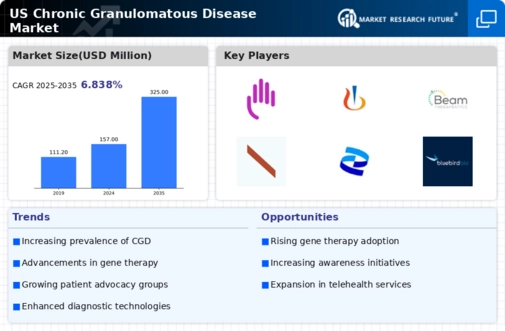The competitive landscape of the US Chronic Granulomatous Disease Market is characterized by a robust presence of companies engaging in innovative therapeutic developments aimed at mitigating the impact of this rare genetic condition. Chronic Granulomatous Disease, which results in recurrent infections and inflammatory manifestations due to impaired immune response, necessitates a focused approach from pharmaceutical companies. The market dynamics are influenced by various factors, including advancements in gene therapy, monoclonal antibodies, and enzymatic treatments, alongside the evolving regulatory frameworks.
Understanding the competitive insights involves analyzing the product offerings, market penetration strategies, and collaborations that define this niche segment within the broader healthcare industry. Companies are investing heavily in research and development efforts to bring forth effective solutions, responding to unmet medical needs and enhancing patient outcomes.
Bristol Myers Squibb
Bristol Myers Squibb holds a noteworthy position in the US Chronic Granulomatous Disease Market, leveraging its strong portfolio of immunotherapies and biologics. The company's commitment to addressing rare diseases showcases its robust research capabilities and strategic focus on enhancing patient care. Their established relationships with healthcare providers, along with a comprehensive understanding of the disease pathology, contribute to the effectiveness of their therapeutic solutions.
The strength of Bristol Myers Squibb lies not only in its innovative product pipeline but also in its significant investments in clinical trials and collaborations with research institutions, which provide valuable insights into treatment advancements. This company is dedicated to raising awareness about Chronic Granulomatous Disease, enhancing patient support initiatives, and fostering partnerships that aim to improve diagnosis and management, solidifying its competitive edge in the market.
Novartis
Novartis also plays a critical role in the US Chronic Granulomatous Disease Market with a strong focus on developing therapies that address the underlying causes of immune deficiencies. The company’s commitment to innovative solutions is evident through its notable offerings, including treatments aimed at enhancing immune responses and reducing infection rates in affected patients.
Novartis has seen considerable success in securing its market presence through strategic mergers and acquisitions, which have broadened its research capabilities and expanded its product portfolio relevant to chronic diseases. The company's proactive approach in aligning with healthcare partners for clinical studies enhances its credibility and fosters a network that supports ongoing patient access to vital therapies.
With a focus on continuous improvement and cutting-edge research, Novartis stands as a significant player contributing to the advancement of treatment options for Chronic Granulomatous Disease in the United States, thus ensuring a competitive presence that adapts to the evolving needs of clinicians and patients alike.























Leave a Comment